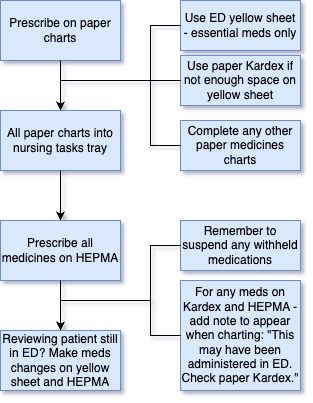In this section : Admission
: Safe and Effective Use of Medicines
Prescribing for CAU Patients Still in ED
Prescribing Advice on Admission – Clozapine
Prescribing Advice on Admission – Methadone/Buprenorphine
Prescribing Advice on Admission – Corticosteroids
Prescribing Advice on Admission – Items Not Prescribed by GP
Prescribing Advice on Admission – Patients on Chemotherapy Regimes
Prescribing Advice on Admission – Medication for Parkinson’s Disease
Prescribing Advice on Admission – Insulin
Prescribing Advice on Admission
Gentamicin & Vancomycin
Greener Inhaler Prescribing
Safe and Secure Handling of Medicines
Blood Glucose & Steroids
Prescribing for CAU Patients Still in ED
Last updated 26th February 2024
Safe and Effective Prescribing and Use of Medicines for Patient Safety
Prescribing
The following procedure should be followed when prescribing for patients who are being clerked in for admission to CAU but are unable to be moved to a bed there within the next two hours due to patient flow issues. Check with the nurse in charge in CAU assessment area if you are not sure.
- The emergency department does not use HEPMA to administer medicines to patients, therefore a paper system needs to be used.
- Use the back page of the yellow ED sheet to prescribe. Ensure you add a patient sticker and complete the allergy status.
- Limit the medicines prescribed on the yellow sheet to those which should not be missed over the next 24-48 hours. Examples include (but are not limited to) levothyroxine, medicines for control of diabetes, medicines for Parkinson’s Disease, anti-rejection medication, anti-epileptic medication, anti-coagulation, essential cardiac medication, analgesia, medication for the acute presenting condition. Add any necessary prn medications.
- Fill out any other required paper medication charts exactly as you would on an inpatient ward (for example insulin, gentamicin, warfarin etc)
- Put the yellow sheet together with any other medicine charts into the designated tray for nurse tasks in the emergency department and ensure the nursing staff are made aware of any urgently required medication.
- If there is genuinely not enough room to prescribe all the essential medications for a patient, ask the nurse in charge for a paper KARDEX and use this instead. Cross through the back of the yellow sheet and circle “KARDEX” so staff will know to look for this.
- Prescribe all medication on HEPMA, ensuring that any withheld medicines are suspended. Add a “note to appear when charting” to any medication which has been prescribed on both HEPMA and Kardex. The note should read “This may have been administered in ED. Please check paper Kardex”.
- If you are reviewing a patient and need to make changes to their medication whilst they are still physically in the emergency department, remember to make those changes on both the yellow sheet and HEPMA.
Content by Alison Moore

